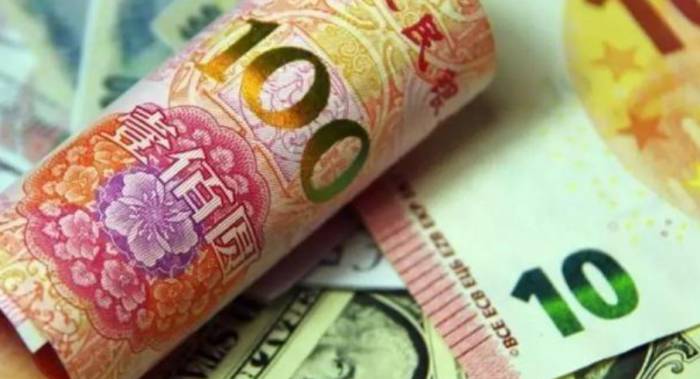
$9.3T US Debt to Be Sold; Yuan Jumps 500 Pts; Dollar-Oil Ties Eroding
01, RMB Fluctuation
Starting at 17:25 Beijing time yesterday afternoon, the offshore exchange rate of the Chinese yuan against the US dollar experienced a significant fluctuation, rapidly falling from 6.98 and breaking through the 7.0 mark in less than half an hour.
However, a more substantial change followed. From 18:10 to 18:50, the yuan experienced a quick upturn, returning to 6.98.
By 21:15 in the evening, the yuan welcomed an even larger surge, rising rapidly from 6.9929 to 6.9527 in just 15 minutes.
It then fluctuated upwards, reaching a peak of 6.9466, with the largest intraday increase exceeding 500 points.
These short-term ups and downs were largely influenced by some short-term news.
The most significant news yesterday was the release of the latest US CPI data, which was better than expected, indicating a clearer sign of inflation peaking and falling. This led to a noticeable reduction in the future interest rate hikes by the Federal Reserve, causing the US dollar index to fall, and the yuan to rise accordingly.
02, The Dollar-Oil System Will Crumble
But in the long term, the future appreciation of the yuan is mainly due to fundamental factors.
A strong supporting factor for the future rise of the yuan has gradually become clear recently, which is that the Gulf oil-producing countries have ultimately decided to expand their oil and gas trade with China in the future and use the yuan for settlement in the trade.For oil-producing countries, this is a good opportunity to break away from the dollar-oil system. At the same time, if they use the Chinese yuan for settlement, it will effectively expand trade between China and Arab countries. They can reduce their dependence on the US dollar and use China's largest market to boost their own economies, so Arab countries are naturally eager to do so.
For China, this is an important step in further enhancing the international status of the yuan. In the first ten months of this year, the proportion of yuan usage in our country's foreign trade is continuously increasing, accounting for 18.1% of the total receipts and payments, compared to 14.7% last year.
Under the complex international environment this year, the use of the yuan has increased significantly. In the longer term, we still have a lot of room for growth. This is because our country imports a large amount of commodities, whether it's oil, natural gas, grain, or iron ore, we are the largest importer.
For oil-producing countries and resource-exporting countries like Brazil and Australia, the Chinese market is a huge market that cannot be ignored. So we must take advantage of this and use the yuan for pricing in commodity imports as much as possible.
03, No need for US debt anymore.In fact, this is not a one-sided demand but a win-win situation.
For oil-producing countries, being tied to the dollar-oil system over the past 50 years has led them to earn a large amount of dollars when exporting crude oil, and then they are forced to exchange these dollars for U.S. Treasury bonds.
Therefore, in previous years, Middle Eastern oil-producing countries held a higher proportion of U.S. Treasury bonds in their foreign exchange reserves.

However, as the scale of U.S. Treasury bonds continues to grow and the credit of the U.S. dollar deteriorates, holding U.S. Treasury bonds has resulted in significant losses, and the possibility of future defaults is also increasing. As a result, in recent years, oil-producing countries have been continuously reducing their holdings of U.S. Treasury bonds.
Taking the largest oil exporter, Saudi Arabia, as an example, in just two years, its holdings of U.S. Treasury bonds have decreased by 30%.
If oil-producing countries export oil to China in the future without pricing it in U.S. dollars, they will not earn a large amount of dollars and will not be forced to hold U.S. Treasury bonds, which is very beneficial for oil-producing countries.
In fact, China's situation is similar. If most of the trade in the future can be paid in Chinese yuan, we will not need to hold a large amount of U.S. dollars.
At present, a significant proportion of China's U.S. dollar reserves is in the form of U.S. Treasury bonds. As of September this year, it still amounts to $930 billion, accounting for nearly one-third of China's foreign exchange reserves.
Since there is no such great demand in the future, we can and should continue to significantly sell off U.S. Treasury bonds, and there is no need to hold these $930 billion "U.S. Treasury bonds that do not know when to return."